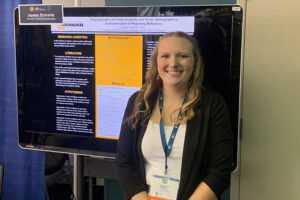
In 2014, UWM became the first school in Wisconsin to offer various tracks to study crime analysis. All 30 slots in the introductory class, taught by UWM’s Helen Bader School of Social Welfare (HBSSW), filled up this spring.
HBSSW offers crime analysis classes – online and in person – to current UWM students in any major and to any college graduates. Current UWM students earn a minor; current UWM criminal justice students earn a specialization; and soon, college graduates can earn a certificate.

Crime analysts gather crime and disorder data, identify and analyze patterns and trends of crimes including arson, homicide, robbery and burglary. They develop recommendations based on their findings, and create and disseminate information that helps criminal justice agencies address crime and allocate resources.
The field is rapidly growing. According to HBSSW Dean Stan Stojkovic, there are not enough trained professionals to fill open positions at agencies including municipal police departments, intelligence fusion centers, sheriff’s departments, state bureaus of investigation, state departments of correction and federal law enforcement agencies.
Stephanie Sikinger (’09 BS, ’11 MS Criminal Justice) was one of the first students to specialize in crime analysis at UWM. (She completed courses before the three tracks were offered.) Today, the Germantown native works as a crime analyst for the Milwaukee Police Department’s Intelligence Fusion Center and teaches a crime analysis course at UWM. In her work, she analyzes data and recommends solutions to help the agency quickly address crimes that pose immediate threats to the community. Singer uses ArcGIS (a geographic information system), spatial statistics and mapping techniques in her work.
“What’s important is being able to understand and interpret the numbers that come back to you, and make decisions based on them.”
Stephanie Sikinger
(’09 BS, ’11 MS Criminal Justice)
“Honestly, without her there would be things not accomplished,” says Carlo Davila, a detective with the MPD Intelligence Fusion Center. “She puts it together and helps steer the resources of the department. Her work is pivotal, essential.”
A day in the life of a crime analyst
Sikinger says there is no typical workday for a crime analyst. “Every day brings a new challenge, a new problem to solve,” she says.
On a recent day, she worked on a robbery in which the suspect uttered a unique phrase before fleeing the scene. Using data-mining software, Sikinger created a formula to identify other crimes in which a suspect used that phrase. The program sifted through police reports and responded. There were multiple robberies in the Milwaukee area in which a suspect used the identical phrase.
This additional information helped the officers make an arrest, she explains.
Sikinger says her job is “fun, challenging, visual. Using software, I can convey a lot of information in a short amount of time. But I’m not a statistician or math whiz. What’s important is being able to understand and interpret the numbers that come back to you, and make decisions based on them. You can have the greatest software on the planet, but unless you can problem solve and use critical thinking skills, the software is useless.”
Students can start immediately on the path to becoming a crime analyst with Introduction to Crime Analysis
Crime analysts like Sikinger also must be able to communicate their findings to others in the police department and work as part of a team that includes personnel on the street.
About the tracks
Successful crime analysts possess a solid understanding of criminal behavior and the criminal justice system; have strong analytic skills as well as strong critical-thinking and problem-solving abilities; and work and reason well under pressure. They also must be excellent communicators – in writing and in speech – because they must present their findings and recommendations to co-workers.
Students can start immediately on the path to becoming a crime analyst with Introduction to Crime Analysis, offered online and in person by UWM’s Criminal Justice Department. There are no prerequisites. “It’s a great way to gauge if this field is for you,” Tina Freiburger, associate professor and chair of the school’s Criminal Justice Department, says.
To create the new tracks and ensure that graduates possess the skills necessary to work in criminal justice agencies, HBSSW worked with a steering committee of federal and local law enforcement officials that included representatives from the Drug Enforcement Administration, Milwaukee County Sheriff’s Department’s Law Enforcement Analytics Division, the Milwaukee Police Department’s Intelligence Fusion Center and the Port Washington Police Department.






